
Swarmwise – The Tactical Manual To Changing The World. Chapter Nine.
Posted: 01 Oct 2013 04:37 AM PDT
Swarm Management: As much as people would like to disrupt the world by going their own way entirely, you cannot change an existing system without also becoming a little part of it in order to change it from the inside. Everybody can change something, but nobody can change everything. Your swarm’s focus probably isn’t on changing the way oldmedia works, so this is how you deal with them.
Swarmwise chapters – one chapter per month
1. Understanding The Swarm
2. Launching Your Swarm
3. Getting Your Swarm Organized: Herding Cats
4. Control The Vision, But Never The Message
5. Keep Everybody’s Eyes On Target, And Paint It Red Daily
6. Screw Democracy, We’re On A Mission From God
7. Surviving Growth Unlike Anything The MBAs Have Seen
8. Using Social Dynamics To Their Potential
9. Managing Oldmedia (this chapter)
10. Beyond Success (Nov 1)
The whole book is available for purchase from Amazon (US, UK) or for download as PDF.
Chapter Nine Below the Line
Continue reading “Rickard Falkvinge: SWARM – Chapter 9 in The Tactical Manual to CHanging the World”






